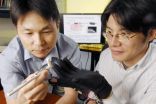(Press-News.org) Newly synthesized polymer, fitted with molecular pincers of carefully tailored structure, effectively captures nicotine molecules and its analogues. The polymer can be used for fabrication of sensitive and selective chemical sensors to determine nicotine in solutions, and in the near future also in gases. Moreover, the polymer is suitable for slow, controlled release of nicotine, e.g., for therapeutic purposes.
The collaboration of researchers of the Institute of Physical Chemistry of the Polish Academy of Sciences (IPC PAS) and of the Department of Chemistry, Wichita State University, Wichita, KS, has resulted in fabrication of a polymer trap for nicotine. Bearing molecular pincers, the polymer effectively captures nicotine molecules and its analogues, and can also release them in a controlled way. The compound will be used in reusable chemical sensors for determination of nicotine for industrial and biomedical purposes as well as in patches for smokers to evenly release nicotine to the body for a prolong time.
"The first nicotine trap has been synthesized by our US partner, Prof. Francis D'Souza, several years ago. It was a sort of molecular pincers, molecules that freely move in solution and form complexes with nicotine therein. Recently, our US-Polish team has been able to fix the pincers inside a polymer. The substance is solid, and that's why we could use it to construct chemosensors", says Prof. Włodzimierz Kutner from IPC PAS.
The core of the polymer nicotine trap, which has been recently filed for a patent, is a metalloporphyrin derivative, a substance present, i.a., in human blood. The molecule contains a ring (a macrocycle) with a centrally located zinc atom and amide pincers attached to this ring. Nicotine binds to this polymer with its two nitrogen atoms: one binds to the zinc atom, whereas the other to the pincers. "It is due to the specific two-point binding that we are surer that the captured molecule is nicotine", stresses Dr. Krzysztof Noworyta from IPC PAS, adding that in one of the devised polymers the pincers are located on both sides of the zinc containing-ring plane. "Such a design clearly increases the efficiency of nicotine trapping", says Dr. Noworyta.
Beside nicotine, the polymer captures also a cotinine alkaloid produced in the metabolism of nicotine and other alkaloids often accompanying nicotine, e.g., myosmine. Polymer binding to nicotine is durable but reversible. It is the property why the new chemosensors for determination of nicotine and its analogues can be used repeatedly.
Nicotine is detected by means of a piezoelectric resonator coated by electropolymerization with a submicrometer thick polymer film. The captured nicotine increases the mass of the film resulting in a decrease in the resonant frequency of the resonator that is easy to measure. "It can be said that we are weighing a film of our polymer all throughout the experiment. Because we know the initial polymer mass and we know that the polymer selectively captures nicotine and its analogues, an increased mass of the film means that these compounds are present in solution", explains Dr. Noworyta.
Quartz acoustic bulk wave resonators used in experiments with the new polymer allow determining nicotine in solutions. In the near future, the researchers from IPC PAS plan to establish collaboration with manufacturers of surface acoustic wave resonators. These resonators oscillate at significantly higher frequencies, thus being more sensitive, and after coating with the nicotine capturing polymer film could detect nicotine also in gases.
In the method described herein, the
detection and determination of nicotine do not need to be confined to weighing. Because nicotine is electroactive, the researchers from IPC PAS are going to measure oxidation current of nicotine trapped in the polymer in parallel with the resonant frequency measurement. Simultaneous measurement with these two methods will increase the detection reliability.
The polymer with pincers for nicotine can be used, among others, in chemosensors devised to analyze nicotine content in tobacco leaves and in biomedical studies to determine nicotine metabolites in patients' body fluids. Another potential application is nicotine patches to help quit smoking. The new polymer could be used for prolong and smooth release of nicotine.
On the Polish side, the research described herein has been performed within the project "Quantum semiconductor nanostructures for applications in biology and medicine". The project, funded in 85% from the European Regional Development Fund, has been awarded to seven Polish research institutions for construction of prototype diagnostic devices on semiconductor substrates, designed for applications in biology, medicine, and environment protection as well as for the development of fundamentals of materials technologies for sensor applications and molecular diagnostics devices. Almost 50 researchers from IPC PAS participate in the project implementation.
INFORMATION:
The Institute of Physical Chemistry of the Polish Academy of Sciences (http://www.ichf.edu.pl/) was established in 1955 as one of the first chemical institutes of the PAS. The Institute's scientific profile is strongly related to the newest global trends in the development of physical chemistry and chemical physics. Scientific research is conducted in nine scientific departments. CHEMIPAN R&D Laboratories, operating as part of the Institute, implement, produce and commercialise specialist chemicals to be used, in particular, in agriculture and pharmaceutical industry. The Institute publishes approximately 200 original research papers annually.
CONTACTS:
Dr. Eng. Krzysztof Noworyta
Institute of Physical Chemistry of the Polish Academy of Sciences
tel.: +48 22 3433217
e-mail: know@ichf.edu.pl
Prof. Włodzimierz Kutner
Institute of Physical Chemistry of the Polish Academy of Sciences
tel.: +48 22 3433217
e-mail: wkutner@ichf.edu.pl
Prof. Francis D'Souza
Department of Chemistry, University of North Texas, 1155, Union Circle, #305070
Denton, TX 76203-5017
tel: (+) 940 369 8832
e-mail: francis.dsouza@unt.edu
RELATED LINKS:
Website of the Institute of Physical Chemistry of the Polish Academy of Sciences: http://www.ichf.edu.pl/
Press releases of the Institute of Physical Chemistry of the Polish Academy of Sciences: http://www.ichf.edu.pl/press/
Polymer's hunt for nicotine
2011-08-06
ELSE PRESS RELEASES FROM THIS DATE:
Fossils of forest rodents found in highland desert
2011-08-06
Two new rodent fossils were discovered in the arid highlands of southern Bolivia by researchers from Case Western Reserve University School of Medicine and Universidad Autónoma Tomás Frías.
The larger of the two rodents, named Mesoprocta hypsodus, probably looked something like a guinea pig on stilts, said Darin Croft, an anatomy professor at Case Western Reserve. The smaller, Quebradahondomys potosiensis, was a spiny rat.
An online article in the Journal of Mammalian Evolution describes the new species, a possible third, and two known species that are new inhabitants ...
Black and White Custom Effect Transforms Family Photographs into Cherished Canvas Prints
2011-08-06
Photo in Canvas provide a premium service to customers looking to transform photographs into exceptional canvas prints. The Hampshire based studio specialise in producing custom effects and one of the latest, contrasting black and white, can completely revamp a tired looking photo.
The designer custom effects range at Photo in Canvas is extensive giving customers plenty of choice when it comes creating their canvas prints. The custom effects are usually free of charge and customers can preview their creations before buying them to ensure everything is at it should be.
One ...
Researchers develop fully cooked food-aid product
2011-08-06
This release is available in Spanish.
U.S. Department of Agriculture (USDA) scientists have developed a fully cooked food-aid product called Instant Corn Soy Blend that supplements meals, particularly for young children.
The work was led by food technologist Charles Onwulata at the Agricultural Research Service (ARS) Dairy Processing and Products Research Unit at the agency's Eastern Regional Research Center (ERRC) in Wyndmoor, Pa.
ARS is USDA's chief intramural scientific research agency, and this research supports the USDA priority of promoting international food ...
Wearable device that vibrates fingertip could improve one's sense of touch
2011-08-06
A little vibration can be a good thing for people who need a sensitive touch.
Researchers at the Georgia Institute of Technology have developed a glove with a special fingertip designed to improve the wearer's sense of touch. Applying a small vibration to the side of the fingertip improves tactile sensitivity and motor performance, according to their research results.
Previous research has shown that adding an appropriate amount of white noise -- a concept called stochastic resonance -- can improve sight, hearing, balance control and touch, but the white noise had not ...
AsiaRooms.com - Asia Fitness Convention to be Held in Bangkok
2011-08-06
Anyone keen to learn about the best ways of staying in shape may enjoy the Asia Fitness Convention (AFC) 2011, which will be held in Bangkok soon.
While the official conference programme runs from October 21st to 23rd, there will be additional sessions taking place before and after those dates in specialist areas such as sports conditioning, ultimate six plus trigger point therapy and freeform body workshop.
The organisers have urged people to register for their tickets as soon as possible, so that they can be sure they do not miss out on the workshops they want ...
Cells die so defensive organs can live
2011-08-06
Researchers demonstrate for the first time that programmed cell death - a process by which cells deliberately destroy themselves - is involved in mandibular regression in termites. And it appears this regression may be the price to pay for the formation of termites' defensive organs, according to Kouhei Toga and Kiyoto Maekawa from the University of Toyama, and Shinichi Yoda from the University of Tokyo, in Japan. Their findings have just been published online in Springer's journal Naturwissenschaften – The Science of Nature.
As termites molt from workers, to presoldiers ...
AsiaRooms.com - Phuket to Host Still Smokin Music and Movie Event
2011-08-06
Jim Newport will be hosting an exhibition of his film and television-related work in Phuket this month, as well as taking the stage with his blues band.
While many people on the island may recognise him from a handful of appearances as the lead singer of Jimmy Fame at the Phuket International Blues Festival, Newport is also an acclaimed production designer.
Among the work that has won him Emmy nominations is baffling sci-fi series Lost, which revolved around a group of people from across the world stranded on an exotic island.
In addition to this, Newport has ...
High-risk stroke patients more likely to get follow-up care after motivational talk
2011-08-06
ANN ARBOR, Mich. — Even though many Americans learn through community health screenings that they are at high risk for having a stroke, they rarely follow-up with their doctor for care.
But a new University of Michigan study shows high-risk stroke patients are twice as likely to get follow-up care from a primary care doctor if they receive a pep talk over the telephone.
"It is unfortunate that these high-risk patients often have a lower rate of follow-up with their primary care physicians," says Rajesh Balkrishnan, Ph.D., associate professor in the College of Pharmacy ...
The last 3 million years at a snail's pace
2011-08-06
Scientists at the University of York, using an 'amino acid time capsule', have led the largest ever programme to date the British Quaternary period, stretching back nearly three million years.
It is the first widespread application of refinements of the 40-year-old technique of amino acid geochronology. The refined method, developed at York's BioArCh laboratories, measures the breakdown of a closed system of protein in fossil snail shells, and provides a method of dating archaeological and geological sites.
Britain has an unparalleled studied record of fossil-rich ...
AsiaRooms.com - Kuala Lumpur Design Week Coming Up in September
2011-08-06
Emerging talents in the creative sphere will come together for Kuala Lumpur Design Week from September 16th to 25th 2011.
With the tagline 'Reaching for the Stars', the event aims to find people with the passion and skill to help Malaysia make an impression on the global stage in terms of design.
The organisers explained that experts from around the globe will share their abilities with eager beginners, with several awards due to be handed out to talents who excel.
In a statement, they added: "The festival is to instil, stimulate and magnify our country's ...



